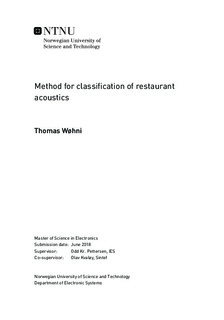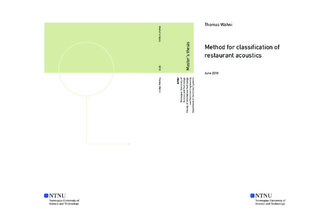| dc.description.abstract | This master's thesis presents a method for classification of the acoustic quality of restaurants. Noise in restaurants makes verbal communication difficult and lowers the quality of the dining experience. It is a common problem that most people can relate to. Still, little is done to improve the situation. The goal of the method presented here is to raise awareness in society on this topic. With this goal in mind, the focus of the method is on simplicity and ease of implementation. The method is based on a single measurement of ambient noise level (both dBA and 1/3 octave spectrum), in occupied state. It requires no active involvement from the restaurants such as access during unoccupied periods. This will hopefully enable a large portion of restaurants to be assessed, over time.
One complicating factor in restaurants is the feedback relationship between speech level and background noise. People tend to speak louder when subjected to noise (the Lombard effect). In multitalker situations where the ambient noise is mostly other talkers, the result can be a rapid escalation of noise. This needs to be factored in when restaurants are evaluated, especially if a single measurement is used. Considering that restaurants are usually never completely full, the maximum noise level is based on 80\% occupancy. Since it's difficult to predict when any restaurant is at 80\% occupancy, the method must be effective for lower rates. In such cases, the maximum ambient noise level is estimated, factoring in the Lombard effect. This estimation process is complicated by cross table distance and the method includes a step for factoring that in.
The measured (or estimated from measured) ambient noise level at 80\% is compared to the speech level. Speech level is assumed from the available models of the Lombard effect, based on standardized statistical models. The resulting ratio between speech and noise (SNR) is used for classification of the acoustic quality. The classes are based on ISO 9921:2003, the international standard for assessment of speech communication. The 1/3-octave spectrum measurement is used for calculation of the SII (Speech Intelligibility Index). The SII is used here to support the conclusion drawn from the dBA measurement.
The end result is presented in three simple terms; "Good", "Okay" and "Bad", with corresponding smiley-face icons. The purpose is to communicate to the potential guests what kind of experience they can expect. This will hopefully raise awareness and provide context for their subjective experiences. The dividing line between good and okay is set to 59 dBA (ambient noise level). I.e the measured or estimated maximum noise level is 59 dBA or less, giving an SNR of 3 or higher. The line between "okay" and "bad" is set to 71 dBA, for an SNR of -3 or worse. The classes are defined to give a realistic view of the kind of experience guests will have. Most likely, very few restaurants will achieve the "good" rating at present time. This is unfortunately an accurate description of the situation and the motivation for the method itself. | |

